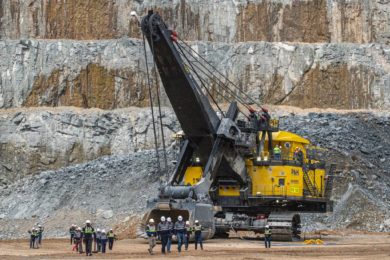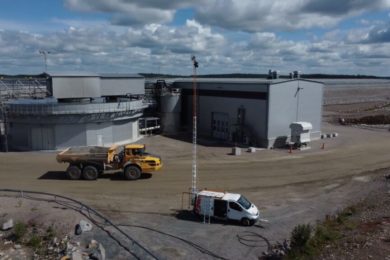FPX Nickel Corp has highlighted the potential for its Baptiste project in central British Columbia to produce refined nickel with a significantly lower carbon footprint than other sources of production in the global nickel industry. These findings are based on the project’s recent Preliminary Economic Assessment (PEA), which outlined the development of a conventional processing facility powered by low-carbon hydro-electric power for the production of a refined, high-grade (63% nickel) product capable of bypassing smelting and being sold directly to end users.
The carbon intensity of Baptiste operations is expected to average 2.40 t of carbon dioxide per tonne of refined nickel production (t CO2/t refined Ni). Baptiste carbon intensity compares very favourably to published literature estimating the carbon intensity of existing nickel production from various mineral deposit types:
-
- 7.19 t CO2/t refined Ni for Class 1 nickel production from sulphide ore
- 27.50 t CO2/t refined Ni for Class 1 nickel production from laterite ore
- 45.00 t CO2/t refined Ni for ferronickel production from laterite ore
- 69.00 t CO2/t refined Ni for nickel pig iron production from laterite ore
“These results, taken in combination with the recent PEA, position Baptiste as a truly disruptive project in the global nickel industry, with the potential to become a significant nickel producer at both low-cost and low-carbon intensity for the electric vehicle battery and stainless steel markets,” commented Martin Turenne, FPX’s President and CEO.
“Importantly, these estimates of Baptiste’s carbon footprint do not account for the potential sequestration of CO2 in the project’s tailings, which our ongoing research collaboration with the University of British Columbia suggests could act as a sizeable carbon storage facility and further lower the project’s net carbon emissions below 2.40 t CO2/t refined Ni. Given the regulatory push by governments in Europe and elsewhere to impose maximum carbon footprint thresholds for electric vehicle batteries, we see the favourable positioning of Baptiste on the global nickel ‘carbon curve’ as a key differentiator for the project going forward.”
Based on the diesel and electricity consumption for mining and processing activities outlined in the PEA, the carbon intensity of Baptiste operations is expected to average 2.40 t of CO2 per tonne of refined nickel production over the project’s 35-year mine life.
The low carbon intensity of Baptiste nickel production is a function of several features specific to the project, including:
- Low stripping ratio: Baptiste has a life-of-mine stripping ratio of 0.40:1, and thus requires lower consumption of diesel for the mining fleet compared to other similar-scale operations with higher overburden and waste content and higher stripping ratios
- Hydroelectric power: The project’s processing facility will be powered by low-carbon hydro-electric power, while a significant proportion of global nickel operations (eg ferronickel and nickel pig iron) are powered by carbon-intensive coal-fired plants
- Refined nickel product with no smelting: Given their high metal content (63% nickel and 30% iron) and low level of deleterious elements, Baptiste’s ferronickel briquettes are expected to bypass the traditional nickel smelting process and be sold as a refined nickel product directly to stainless steel producers, thereby avoiding the carbon emissions associated with the smelting and refining of typical nickel sulphide concentrates
The Baptiste PEA demonstrates the potential for establishing a greenfield open-pit mine and an on-site magnetic separation and flotation processing plant, using conventional technology and equipment. At a throughput rate of 120,000 tonnes per day (or 43.8 Mt/y), annual production is projected to average 44,932 t nickel contained in ferronickel briquettes grading 63% nickel at C1 operating costs of US$2.74 per pound ($6,038 per tonne) of nickel.
The company’s Decar Nickel District claims cover 245 square kilometres of the Mount Sidney Williams ultramafic/ophiolite complex, 90 km northwest of Fort St James in central British Columbia. The District is a two-hour drive from Fort St James on a high-speed logging road.
Decar hosts a greenfield discovery of nickel mineralisation in the form of a naturally occurring nickel-iron alloy called awaruite, which is amenable to bulk-tonnage, open-pit mining. Awaruite mineralisation has been identified in four target areas within this ophiolite complex, being the Baptiste deposit, the B target, the Sid target and Van target, as confirmed by drilling in the first three plus petrographic examination, electron probe analyses and outcrop sampling on all four. Since 2010, approximately US$24 million has been spent on the exploration and development of Decar.
As reported in the current NI 43-101 resource estimate, having an effective date of September 9, 2020, the Baptiste deposit contains 1.996 billion tonnes of indicated resources at an average grade of 0.122% DTR nickel, containing to 2.4 Mt of nickel, plus 593 Mt of inferred resources with an average grade of 0.114% DTR nickel, containing 0.7 Mt of nickel, both reported at a cut-off grade of 0.06% DTR nickel.










